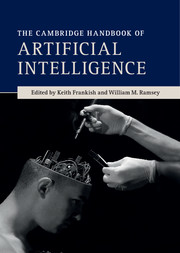Book contents
- Frontmatter
- Contents
- List of figures
- Notes on contributors
- Acknowledgments
- Introduction
- Part I Foundations
- Part II Architectures
- Part III Dimensions
- 7 Learning
- 8 Perception and computer vision
- 9 Reasoning and decision making
- 10 Language and communication
- 11 Actions and agents
- 12 Artificial emotions and machine consciousness
- Part IV Extensions
- Glossary
- Index
- References
8 - Perception and computer vision
Published online by Cambridge University Press: 05 July 2014
- Frontmatter
- Contents
- List of figures
- Notes on contributors
- Acknowledgments
- Introduction
- Part I Foundations
- Part II Architectures
- Part III Dimensions
- 7 Learning
- 8 Perception and computer vision
- 9 Reasoning and decision making
- 10 Language and communication
- 11 Actions and agents
- 12 Artificial emotions and machine consciousness
- Part IV Extensions
- Glossary
- Index
- References
Summary
The wish to build artificial and intelligent systems leads to the expectation that they will operate in our typical environments. Hence, the expectations on their perceptual capabilities are high. Perception refers to the process of becoming aware of the elements of the environment through physical sensation, which can include sensory input from the eyes, ears, nose, tongue, or skin. In this chapter we focus on visual perception, which is the dominant sense in humans and has been used from the first days of building artificial machines. Two early examples are Shakey, a mobile robot with range finder and camera to enable it to reason about its actions in a room with a few objects (Nilsson 1969), and FREDDY, a fixed robot with a binocular vision system controlling a two-finger hand (e.g., Barrow and Salter 1969).
The goal of computer vision is to understand the scene or features in images of the real world (Ballard and Brown 1982; Forsyth and Ponce 2011). Important means to achieve this goal are the techniques of image processing and pattern recognition (Duda and Hart 1973; Gonzales and Woods 2002). The analysis of images is complicated by the fact that one and the same object may present many different appearances to the camera depending on the illumination cast onto the object, the angle from which it is viewed, the shadows it casts, the specific camera used, whether object parts are occluded, and so forth. Nevertheless, today computer vision is sufficiently well advanced to detect specific objects and object categories in a variety of conditions, to enable an autonomous vehicle to drive at moderate speeds on open roads, to steer a mobile robot through a suite of offices, and to observe and to understand human activities.
Keywords
Information
- Type
- Chapter
- Information
- The Cambridge Handbook of Artificial Intelligence , pp. 168 - 190Publisher: Cambridge University PressPrint publication year: 2014
References
Accessibility standard: Unknown
Why this information is here
This section outlines the accessibility features of this content - including support for screen readers, full keyboard navigation and high-contrast display options. This may not be relevant for you.Accessibility Information
- 2
- Cited by
